
Goods can be effectively displayed on a variety of fixtures such as gondolas, tables, cubes, mannequins, waterfalls, shelves, display cases, and manufacturer point-of-purchase displays.
A fixture should not only complement the merchandise, but also the atmosphere created in the store. Each fixture should introduce the merchandise to the public and thereby act as a silent salesperson.
Outlined below are some basic rules for fixture placement. These are not absolutes, but rather guidelines that fit in well with store set-up and customer-traffic patterns.
- Allow 1.2 meters between shelves, requirements for aisle width varies from 1.2 to 2.4 meter. The most common aisle width is 1.8 meter.
- The aisle leading directly to the fire exit is considered a major aisle. Do not block the fire exit with fixtures or unimportant materials.
- A well-planned, geometric aisle pattern works best to maximise sales.
- Place aisle displays on an island rather than wing fixtures.
- When placing shelves, progress from small (sized or capacity) fixtures at aisles to large fixtures near the back walls. When working with hard goods, place cubes in the front with gondolas to the rear of the department or store.
- Higher-priced stores require fewer fixtures because there is less stock. Primarily use T-stands and four-ways to create an illusion of space and selective goods. This feeling is necessary to sell higher-priced goods.
- Create exciting displays of mass merchandise by using quantity and colour. Display merchandise in quantity on quads, Bloomingdales, rounders, and T-stands; use cubes for folded goods.
- Fixtures that work well for sale items include tub tables, round shelves, and rectangular shelves.
Rails
Rails are commonly used for clothing and items that can be hung. Rails can have different shapes and sizes. Some can be adjusted according to height and can be loose-standing or fixed to walls. Rails make it easy to merchandise items together and can be moved to create a specific “look and feel” according to the floor layout plan.
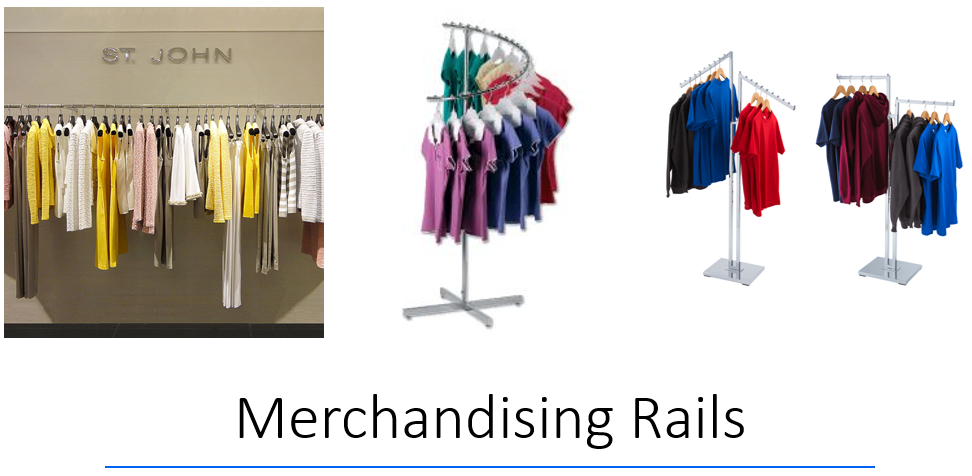
Shelves
Shelves are also commonly used and can be used in more instances than rails. Shelves can be used in almost any store, from green grocer, butchery, to supermarkets and hardware stores.
Normally, shelves can be adjusted to fit the merchandise on promotion. It is important that shelves are adjusted to the correct height in terms of the merchandise, but also in terms of customer reach. It is very frustrating if things are stacked on shelves that are too high for customers to reach. The depth of shelves must also be practical; if they are too deep, customers cannot reach the back, which means that they cannot reach the items without assistance. Not all customers want to ask for assistance and they might just decide not to buy anything. Promotional merchandise must be enticing enough and attractive to be bought. The shelves used for promotional goods must be decorated and appear different from the regular shelves.
Empty shelves are wasted space. It is important to keep them merchandised to maximum capacity. This means regular replenishing. If you are out of stock, it is important to re-merchandise the existing, or to pack something else in that specific place.
The best level for merchandising is at “eye-level”. This means that customers must be able to see the merchandise as they walk past the shelves. Obviously not all items can be merchandised at eye-level and it is therefore important to decide what items are merchandised at what levels. Refer to your company’s operational and shelving guidelines with regard to this.
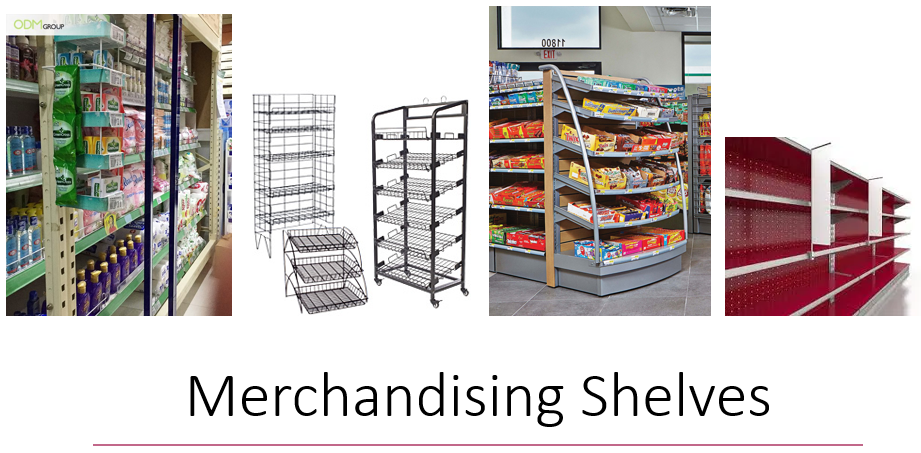
Bins and Baskets
Bins and baskets are often used for special promotions and to attract customer attention. The advantage of this is that the bins and baskets can be placed in strategic positions and do not have to be part of the permanent displays.
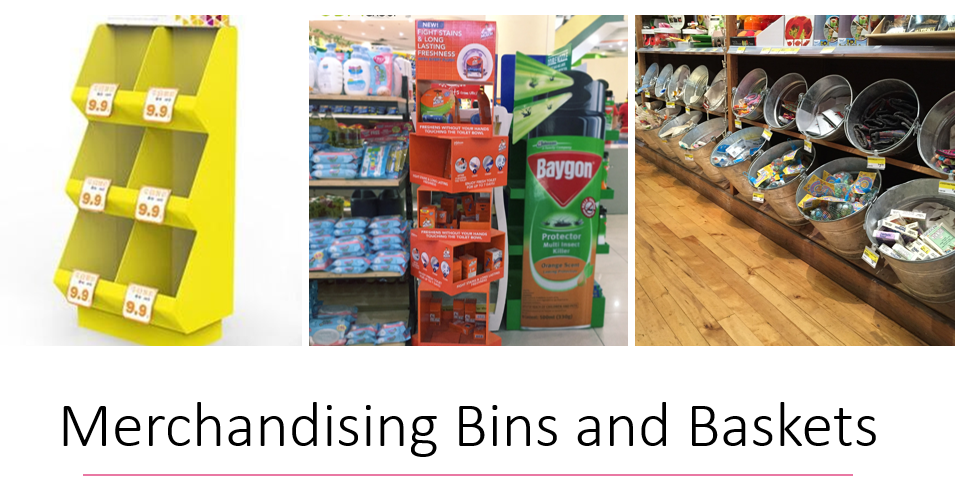
Gondolas
Gondolas are units created for merchandising and they normally provide the space for combined merchandising, for example hanging space as well as shelving. Gondolas are usually on wheels and can be moved around. Gondolas are also quite often used for promotional merchandise.
- One of the most common fixtures in stores are gondolas; movable shelving approachable from all sides used in self-service retail stores to display merchandise.
- They can be lined up in rows as in grocery, hardware and drug stores or used singly to create an island.
- End-caps are units at the end of aisles. End-caps are important selling locations and should be used for high-profit impulse or seasonal merchandise. Related merchandise should be grouped together on the end-cap and gondola sides. The end-cap should indicate the type of related merchandise on the gondola sides. For example, golf balls displayed on an end-cap should indicate that related golf accessories are located on gondola sides.
- Customers generally look to the centre of gondola sides first, and then to either the right or left.
- Additional high profit impulse items should be placed in the centre of gondola sides and other related merchandise to either the right or left.
- Larger more expensive merchandise should be placed to the right.
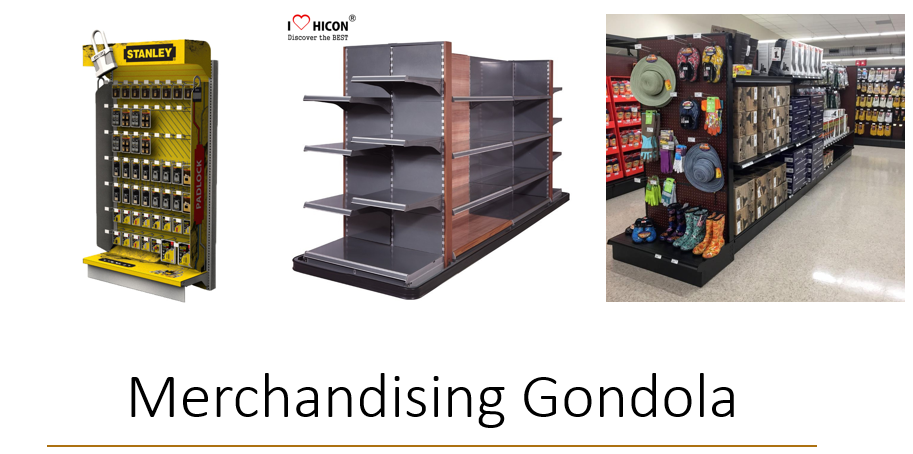
Tables
Tables can be used to display merchandise on a permanent or promotional basis. Tables can be used almost anywhere for any merchandise as it is visible to customers. Tables can also be used when merchandise is demonstrated. One negative aspect of tables is that they are sometimes more difficult to keep tidy and stock losses can occur easier.
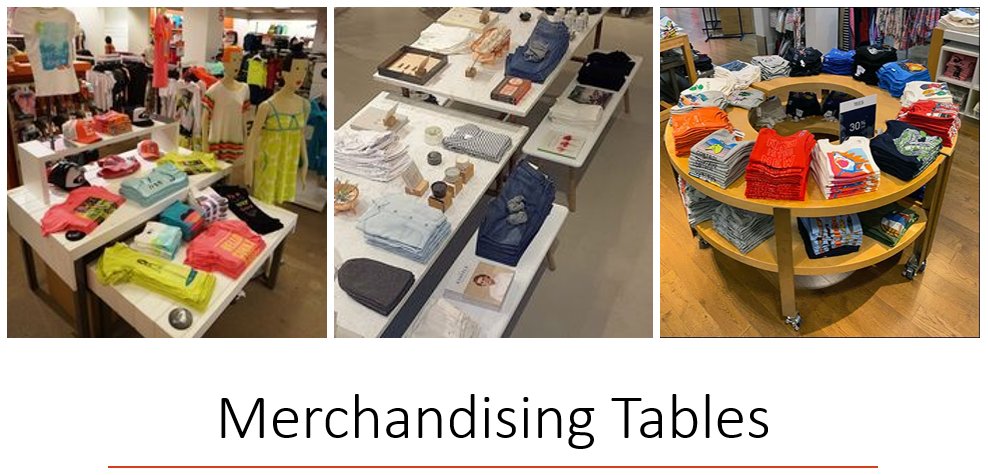
Props
A prop is something used with a product in a display that clarifies the function of the merchandise being sold or the story being told. Props are an integral part of a display. They are used in visual merchandising to tell a story about the product, the merchandise concept, or the store itself.
A display prop may be something that is not for sale, such as floor coverings, wall treatments, backgrounds, mannequins, shelves, and steps. Props may also be merchandise that is for sale, but is not the theme merchandise, such as golf clubs used in conjunction with golf wear. Merchandise from other departments used to highlight saleable items can lead to multiple sales. Visibility is provided for the original theme merchandise, in addition to the prop merchandise.
When using saleable merchandise as a prop, be sure it is appropriate for the theme of the display and in sufficient quantity to meet an increase in demand arising from the display. Prominently display theme and prop merchandise in their respective departments for easy access by the customer.
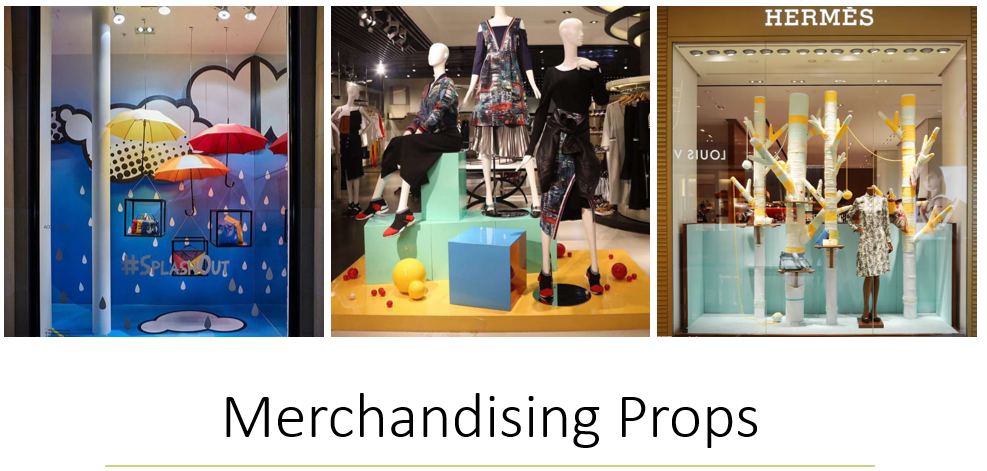
If a store does not have merchandise available that can be used in a display, use display props from non-merchandise categories. Non-merchandise props used for their original purpose can assist in telling a story. Examples include tissue paper, pens, pencils, shopping bags, hangers, chairs, desks, and tables.
Props may also be natural or ordinary objects such as items carried in from the woods or veld, or rustic antiques found in someone’s attic. Examples include a branch from a lilac bush for a spring or summer theme; shocks of wheat, dried leaves and wood crates of assorted sizes used to enhance a fall theme; large boulders used to give the idea of strength and power to a tractor; and grey rocks to provide contrast to jewellery. These object props are generally not beautiful by themselves but highlight the merchandise for sale.
Commercially made props are readily available. When selecting props to purchase, be certain of their quality. Inspect the props prior to accepting the shipment to be sure the props are not broken.
The merchandise in a display should always be the dominant element. The prop is there to complement or highlight the saleable merchandise and add visual excitement to the surrounding area. A prop is not there to distract the customer from their original purpose of shopping for and purchasing goods.